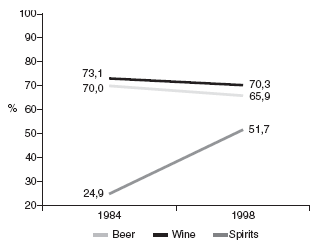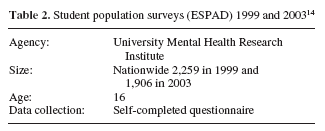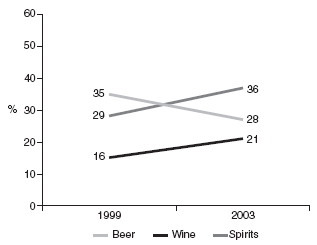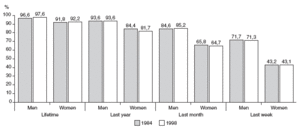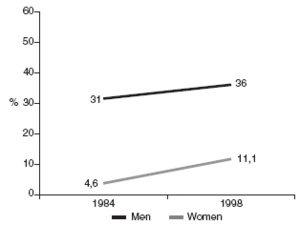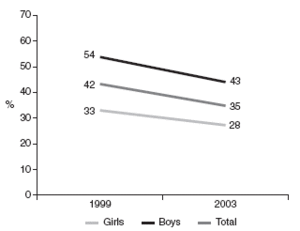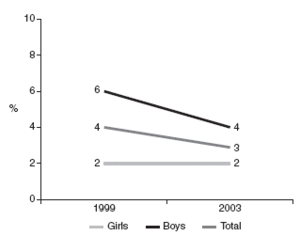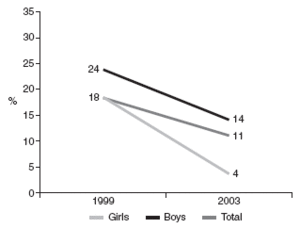student population nationwide epidemiological surveys; c) preventive and treatment agencies; d) Traffic police; and e) General State Chemical Laboratory. Results: The approach to the situation of alcohol-related issues in Greece is piecemeal. However, there is a growing government concern over alcohol issues as demonstrated by actions taken within the framework of legislation and treatment facilities. Conclusions: The existing monitoring system must be extended. In order to have the full picture of the phenomenon, close collaboration with more agencies/sources of information is needed, as well as a synthesis of results from individual sources.
Introduction
Alcohol consumption is culturally integrated in Greek society. In-house production is also quite high in several regions of the country. In Greece, as in many other Mediterranean societies, drinking is interwoven with many aspects of social life. It forms part of everyday life and is imperative in negotiating and affirming social relations1.
This paper will try to provide an overview of the current Greek situation with regard to the alcohol use and abuse phenomenon. It does not examine the definitions of the terms use and abuse, problem use, dependence or alcoholism, as this would fall outside its scope. In this paper, alcohol abuse (or problem use, dependence, addiction, alcoholism) denotes a pattern of use leading to the development of persistent, serious alcohol-related difficulties in the individual2-3. The description of the Greek situation is based on data collected by the University Mental Health Research Institute (UMHRI), as part of the epidemiological studies and the work of the Greek REITOX Focal Point (FP) (the Greek FP belongs to the University Mental Health Research Institute [UMHRI], which is a body corporate under private law) of the European Monitoring Centre for Drugs and Drug Addiction (EMCDDA) in the period 2001-2003. The agencies/sources of information include: a) the NOMOS electronic legal database; b) nationwide epidemiological surveys on general and student population; c) preventive and treatment agencies; d) Road Traffic Police; and e) General State Chemical Laboratory.
Monitoring alcohol in Greece
Alcohol monitoring became part of the Greek FP national tasks in 2002. In order to meet this need, the Greek FP established a national information network consisting of every possible agency dealing with the phenomenon of (problem) alcohol use. In addition, it annually collects national data on the surveys/studies conducted by agencies and individuals in Greece and edits the Bibliography on Alcohol, the only integrated one with national coverage.
The aforementioned activities aim at the development of a nationwide alcohol monitoring system similar to the already established drug information system, so as to assess the extent of the phenomenon of alcohol use and its trends over time.
The results coming from individual sources are presented below.
Legal framework
The legislation in force concerning alcohol is governed by the same principles as the ones that apply to all legal products or substances on the free market and stipulates the same control status. Moreover, the production, alteration and trade of spirits are regulated by the provisions of a law on alcohol enacted in 2001 (Law 2969/01). There are also regulations introduced by the Code on alcohol taxation and by the Code on duties on alcohol4. Furthermore, there are laws for the protection of minors (Presidential Decree 180/1979, Presidential Decree 36/1994), as well as laws for the protection of public security (Law 2696/1999, Ministerial Decree 2403/1989 as amended by 1709/1993, Penal Code art 34, 35, 36). There are also legal restrictions (Law 2328/1995, Presidential Decree 100/2000) on the content of media advertisements, but there is no law that bans them.
Moreover, in 2002 the need to organise the services required for the monitoring and treatment of all aspects of alcohol use and abuse has led to a ministerial decree (42709/23.04.2002) that stipulates the establishment of a committee to formulate the respective context. In the same year, the legal blood alcohol concentration level in certain categories of drivers (professional and novice drivers, i.e. those having a driving licence for less than 2 years) was reduced from 0.50 to 0.20 gr of ethanol per litre of blood (or from 0.25 to 0.10 mgr of ethanol per litre of exhaled air) pursuant to the relevant joint ministerial decree (43500/5691/24.7.2002).
With regard to the treatment of alcohol and opioid addiction, in 2003 the requirements for the administration of antagonists, such as naltrexone and naloxone, within the framework of a therapeutic procedure were drawn up.
Furthermore, in 2003 the deputy prosecutor of the Supreme Court recommended the enforcement of a 1994 presidential decree (PD 36/1994), which prohibits minors under 17 from entering nightclubs and bars or from consuming alcoholic beverages in other licensed public establishments, when unaccompanied by their parents or guardians. The aforementioned decree had been in disuse until then. For this reason, this action is of great importance, since for the first time emphasis was laid on the issue of providing alcohol to the underaged5.
In Greece the legal age for drinking alcoholic beverages on premises of direct consumption is 17 years, while there are no age restrictions on drinking or buying alcohol off such premises. Moreover, no restrictions are imposed on the place of alcohol consumption, with the exception of some restrictions in effect at the means of mass transportation and at athletic events. In much of the world, the age limits for buying alcoholic beverages varies from 15 to 21 years6.
Epidemiological surveys
The nationwide epidemiological surveys aim to provide a more exact picture of trends in drug and alcohol use. The University Mental Health Research Institute carries out repeated epidemiological surveys on general and school population. The data presented here reflect the frequency and the patterns of alcohol consumption.
General population data
More specifically, data on trends in the general population alcohol prevalence are based on the two surveys conducted in 1984 and 19987-9 (Table 1).
As regards the main trends deriving from these two studies, a comparison between the two years reveals that alcohol consumption rates are steady over the years4. Moreover, gender differences increase as the reference periods become shorter (from lifetime to last week consumption) (Figure 1). This difference in the frequency of alcohol consumption between men and women has also been observed in previous surveys10,11.
Figure 1. Alcohol consumption in general population by gender (1984 and 1988).
As regards the types of alcoholic beverages usually consumed, although the majority prefers wine or beer to spirits, the consumption of spirits seems to have doubled in 1998, compared to 19844 (Figure 2).
Figure 2. Frequency of consumption some times per month by type of alcoholic beverage (1984 and 1988).
Another interesting aspect of excessive alcohol consumption relates to the occasions of «drunkenness». The frequency of episodes of drunkenness could be an indicator of hazardous alcohol use12. As shown in Figure 3, the rates of reported drunkenness (3 times or more in lifetime) increase from 1984 to 1998 for both genders. In addition, it seems that this behaviour is more common among men than among women (Figure 3). This finding is supported by another study, in which attendance of patients for excessive alcohol consumption at the emergency department of a General Hospital was investigated. One of the findings was that 62.6% of the total number of patients were men and 37.4% women13.
Figure 3. Proportion of population who has been drunk 3 times or more in lifetime (1984 and 1988).
School population data
Epidemiological data on trends in alcohol use in Greece in students aged 16 derive from the ESPAD (European School Survey Project on Alcohol and other Drugs) study, conducted by the University Mental Health Research Institute (Table 2).
According to these data, the proportion of students who reported frequent consumption of alcohol (40 times or more in lifetime) in Greece decreased from 42% in 1999 to 35% in 2003 (Figure 4). This finding applies to all reference periods under consideration, i.e. consumption in lifetime, during the last 12 months and during the last 30 days14.
Figure 4. Changes between 1999 and 2003 in lifetime use of any alcoholic beverages 40 times or more.
As shown in Figure 4 and in line with the general population results presented above, higher proportions of boys than girls report frequent consumption of alcohol (43% and 28%, respectively), a finding supported by a number of publications10,15-18.
In terms of prevalence rates of lifetime frequent use of alcohol, Greece is among the 10 top countries in both periods (in a total of 30 countries in 1999 and 35 countries in 2003), but has fallen down the list since 1999. As far as «binge drinking» (i.e. excessive consumption on a single occasion) is concerned, Greece is among the countries with the lowest rates in both periods14.
Contrary to the high percentages of reported frequent alcohol consumption, the proportion of students who report drunkenness is low. In 2003, 3% of the Greek students report incidents of drunkenness 20 times or more in lifetime. Prevalence rates are relatively steady between 1999 and 2003, with a downward trend (4% in 1999 and 3% in 2003). Again, more boys than girls report this behaviour, although between 1999 and 2003 the proportion of boys decreased while the proportion of girls remained stable (Figure 5). Greece holds on to its low ranking in both periods14. As Schmid et al.19 point out, the countries of Southern Europe present low rates of drunkenness, as opposed to the Scandinavian and the Baltic countries.
Figure 5. Changes between 1999 and 2003 in the proportion of students who have been drunk 20 times or more in lifetime.
In 2003 compared to 1999, spirits consumption overtook that of beer, while wine consumption remained at the lowest position (Figure 6).
Figure 6. Changes between 1999 and 2003 in consumption of beer, wine and spirits 3 times or more during the last 30 days.
The frequency of «binge drinking», i.e. drinking five or more drinks in a row on one drinking occasion, is a sign of heavy or problem alcohol use14. The percentage of Greek students who reported this behaviour 3 or more times in the last 30 days decreased between 1999 and 2003 (Figure 7). This important change is observed in both sexes. As with drunkenness, Greece compared to the ESPAD countries remains in the lowest positions14.
Figure 7. Changes between 1999 and 2003 in the proportion of students who have reported «binge drinking» 3 times or more during the last 30 days.
Treatment and preventive interventions
Preventive interventions
In terms of the implementation of prevention activities against substance use/abuse, the Greek FP collects detailed data on every intervention area in the prevention field. Data on school-based interventions, youth programmes outside school, parent programmes, early childhood interventions and prevention interventions in recreational settings are collected on an annual basis through questionnaires distributed to all existing prevention agencies20.
There currently exist 63 Prevention Centres against drugs and/or substance use, which are co-financed by the Organisation against Drugs (OKANA), the Local Authorities and other local agencies. Furthermore, Local Authorities, governmental and non-governmental organisations, voluntary organisations and the Church operate prevention programmes, as well. The activities of all the aforementioned agencies are based on the philosophy of health education and promotion. Within this framework, they aim at substance addiction prevention and health promotion in general. This means that the existing prevention agencies do not focus on alcohol consumption only; rather, they implement alcohol-related interventions as part of a broader mobilisation strategy regarding substance use.
Prevention professionals recognise the significance of prevention interventions implemented in the school setting. The importance of the institution of school in substance abuse prevention is emphasised in the findings of researches conducted in Greek schools21-23. Along these lines, the Ministry of Education develops Health Promotion Programmes in Primary and Secondary Education with a special focus on alcohol use prevention. Furthermore, some of the aforementioned prevention agencies organise special alcohol-focused activities in schools. Such activities are addressed to educators, pupils and parents.
Still, special alcohol-focused interventions in schools are limited. Moreover, a study has suggested that research data are not fully utilised in terms of planning interventions in the drug abuse field. This gap between research and practice seems to be attributed to the lack of communication between researchers and practitioners in the field of prevention and harm reduction or between researchers and policy makers24.
In addition, interventions in the wider community are also developed. Some of the aforementioned agencies develop special preventive activities against alcohol use, i.e. meetings or seminars on alcohol-related issues and distribution of information material in order to sensitise specific population groups (e.g. school teachers, parents, etc.)20, although such initiatives are fragmented.
Treatment options
Data reflecting treatment delivery are gathered by the Greek FP by means of a special questionnaire (Treatment Unit Form/TUF A)5. This instrument collects information about the structural and functional features of the main treatment phase (i.e. therapeutic communities). Data are collected on an annual basis (for alcohol treatment units since 2002).
As already stated, in Greece alcohol use is a socially acceptable habit. Hence, more often than not, problematic consumption (i.e. alcohol abuse and addiction) is not recognised as a problem25,26. As a consequence, problematic drinkers may not readily approach treatment services to seek therapeutic help for their problem. On the other hand, the treatment options available for alcohol dependent/abusing individuals have been limited so far. Yet, albeit limited, the available data on problematic alcohol consumption have recently alarmed the public27 and mobilised the agencies to extend the treatment network for problematic drinkers and alcohol addicts.
As far as treatment availability is concerned, alcohol dependent/abusing individuals were officially offered therapeutic help for the first time in 1987, in the context of a Drug and Alcohol Dependence Treatment Unit run by the Attica State Psychiatric Hospital. Today, 17 years later, specialised alcohol recovery treatment is available in 5 officially recognised treatment units. It should be mentioned, however, that these does not include private clinics that might accept alcoholics, as they are not officially approved structures.
In addition to the programmes mentioned above, 4 out of the 44 drug treatment programmes operating in the country in 2003 also served individuals having alcohol as the primary substance of abuse. It should be noted, however, that the share of alcoholics entering treatment in programmes mainly addressed to illegal drug users is low5. This could be attributed to the fact that in many cases alcoholics do not consider themselves as problem users, much less identify themselves with drug addicts.
Moreover, within the broader range of therapeutic interventions targeting alcohol addicts, there are also initiatives based on the therapeutic value of self-help. A review of the relevant literature internationally reveals the advantages --in terms of effectiveness-- of therapeutic approaches that espouse and implement the key concepts and techniques of self-help over those that rely exclusively on traditional professional therapeutic models28,29. In Greece, the Open Psychosocial Support Programme operates under the auspices of the Aristotle University of Thessaloniki and OKANA. Self-help groups are also organised by Alcoholics Anonymous in various areas of the country. Although such interventions are not integrated treatment programmes, they are considered to be of critical importance, since they enhance the personal abilities and social skills of people in need by means of active interaction29,30.
Main features of alcohol treatment programmes
In view of providing a global overview of the situation of alcohol-related treatment in Greece, some qualitative data will be presented below for the 5 programmes specialised in alcohol recovery that delivered main treatment (i.e. therapeutic communities) during the year 2003.
As far as the organisational framework is concerned, 3 programmes belong to state hospitals, one is part of the Department of Psychiatry of the University Medical School and one belongs to the non-governmental sector. All treatment services are non profit. As far as the sources of funding are concerned, all programmes are fully subsidised by the government.
The types of the existing treatment programmes are as follows: 3 outpatient (Recovery Unit from Alcohol, Pharmaceuticals and Gambling, ATHENA Therapeutic Programme, and ALFA Therapeutic Programme), one inpatient (18 ANO Psychological Recovery Unit for Alcohol Users) and one mixed programme, which includes both outpatient and inpatient structures so as to meet the particular needs of individual alcohol users, such as different working hours or different stages of addiction (18 ANO Short-term Therapy Unit)5. Almost all programmes follow a multi-stage therapeutic procedure consisting of counselling, detoxification, treatment and rehabilitation.
Medically assisted treatment in the field of alcohol recovery is not fully developed. Only one unit foresees the parallel administration of naltrexone. This may be explained by the fact that only recently (in 2003) -as mentioned in the section on the legal framework- have the requirements for the prescription of antagonists as part of the therapeutic procedure been defined.
Moreover, in accordance with the philosophy and the theoretical principles of each agency, various types of counselling and therapy are applied during the therapeutic procedure for alcohol recovery. All treatment programmes lay emphasis on relapse prevention, as it is recognised that the process of protecting a former user from returning to his/her previous lifestyle and consequently to addictive/problematic behaviour is the most crucial part of therapy30,31. Besides, it is assumed that the therapeutic procedure is long-lasting and presupposes a multi-faceted approach, taking into account the personality of the patient and his/her environment31. Thus, special emphasis is placed on the psychological, emotional and social support of alcoholics. Within this context, most of the programmes (i.e. 4 programmes) include in their treatment approaches individual support or counselling, individual psychotherapy, medical/psychiatric care and family therapy. Finally, 2 programmes also place emphasis on the organisation of group activities, such as group therapy and self-help groups5.
Admittedly, alcohol addicts are not a homogenous group as far as their needs are concerned32,33. It has also been asserted that alcoholism is not a one-dimensional concept, but a «synthesis» of behaviours and symptoms25. Consequently, it is assumed that the full benefit of the treatment procedure can only occur when the therapeutic techniques applied do take into consideration the unique aspects of the individual32. Along these lines, further to the therapeutic intervention per se implemented in the context of the above programmes, the provision of additional services also plays a significant role, so as to fully cover the needs of this population.
A large body of scientific work has shown that a large percentage of alcohol dependent/abusing individuals is also diagnosed with psychiatric symptomatology33,34 as quoted in 25. In compliance with these findings, all 5 alcohol recovery programmes provide psychiatric help. Moreover, 3 programmes offer basic medical help.
Other services provided to patients in the context of the main treatment phase include housing assistance (2 programmes), as well as career guidance and help in job seeking (1 programme). The above provisions have a social objective and aim to facilitate the efforts of recovering alcohol addicts towards successful social reinsertion.
To achieve the same objective, the 2 programmes implemented by the Attica State Psychiatric Hospital provide social reintegration services after the completion of the main treatment phase, in the framework of specialised units. These specialised units view the social rehabilitation phase as a transitional process involving continuous education and training in a new way of life which is open to dialogue and change30. The services provided in this context include individual and group psychotherapy, drama therapy, organisation of self-help groups, while in certain cases the patients receive family or couple counselling.
Beyond the aforementioned general services, 2 programmes offer specific services tailored for certain special population subgroups, i.e. dually diagnosed individuals and migrants or refugees.
The specific criteria set by each programme to define successful completion are of great significance, since they are indicative of the goals of the therapeutic procedure and of the treatment approach adopted by the programmes. More specifically, the existing treatment programmes report that the following criteria should be met upon exit from the main treatment phase: a) abstinence from alcohol and other substances (all programmes); b) improvement of family relations (2 programmes); c) harm reduction (1 programme); d) abstinence from deviant behaviour (1 programme); and e) acquisition of skills for everyday problem management (1 programme)5. It is clear that these criteria are not strictly related to abstinence from the substance, but also envisage a general improvement of the alcohol user's quality of life. This is in line with the view that treatment planning should address all the needs of patients rather than be targeted solely at abstinence from substances35.
Quantitative data on the operation of the programmes in 2003
According to quantitative data for the 5 specialised alcohol treatment programmes that delivered main treatment in 2003, their total capacity comes up to 416 individuals. It should be noted that this number refers to the average number of clients that can be served monthly by the existing units. Nonetheless, it should be clarified that 3 out of the 5 programmes also treat other types of addiction, such as illicit substances, pharmaceuticals and gambling. The aforementioned capacity, thus, also includes those groups of patients5.
With regard to the patients who entered treatment for their alcohol problems in 2003, there were 538 admissions in total. It should be mentioned here that this number is not comparable with the available slots (i.e. capacity), given that the duration of the programmes varies and some patients may complete treatment during a reporting year, whereas others may drop out or be discharged. Nonetheless, 3 treatment programmes report having a waiting list of 45 individuals for admission to various phases of the therapeutic procedure (pre-admission, detoxification and main treatment phase)5. This number of individuals waiting to be admitted to the programmes -although relatively small- may be an indication that the available treatment services are not sufficient for the existing needs.
Socio-demographic characteristics of alcohol users approaching treatment services
Information on the dimensions of problem alcohol use, the profile of problem users and their use patterns can be helpful in identifying patterns in the use of services, assessing resource needs, and planning and evaluating services for people with alcohol-related problems. It may also be an indicator of trends in problem alcohol use.
The Greek FP so far has been able to collect only aggregated data on a limited number of socio-demographic variables by the few existing treatment agencies. Data refer to people who contacted 5 treatment interventions (18 ANO Therapeutic Unit, ATHENA Therapeutic Programme, Recovery Unit from Alcohol, Pharmaceuticals and Gambling, ALFA Therapeutic Programme and Open Psychosocial Support Programme) in order to request or start treatment for their alcohol use. The following conclusions can be drawn from the aggregated data collected by the FP in 2003 and from a relevant study36:
-- The percentage of men approaching treatment services is higher (58.5%-84.9%) than that of women (15.1%-41.5%). However, in two programmes the ratio between men and women has decreased significantly compared to 2001 and 2002, a finding that has to be followed over time in order to come to safe conclusions.
-- The majority of problem alcohol users belong to the 36-50 age group, often followed by the over 51 age group.
-- The percentage of problem alcohol users who have a steady employment is high and ranges from 31.7% to 55.7%. The percentage of the unemployed ranges from 17% to 33.3%.
-- As regards the education status, one quarter (26.9%) appear to be higher education graduates5.
In conclusion, the profile of the problem alcohol user is a male, 36-50 years old, employed and often highly educated. We must, however, point out that a much larger number of characteristics is needed in order to have an accurate picture of the problem alcohol user's profile.
Road traffic police
Worldwide, an estimated 1.2 million people are killed in road accidents each year and as many as 50 million are injured. According to WHO, alcohol is one of the five major risk factors that contribute to road injuries37.
In Greece, the Road Traffic Division of the Hellenic Police at the Ministry of Public Order provides data on road accidents, as well as on alcohol-related checks and offences.
In the period 2001-2003, the European Commission financed Greece among other countries in order to promote information campaigns against driving under the influence of alcohol. In the year 2002, specially planned and coordinated actions were launched by the Hellenic Police within the framework of the Strategic Inter-Ministerial Road Safety Programme «On the Road 2001-2005». As a result, in 2003 a significant reduction in road accidents and a 23.6% reduction in deaths were recorded compared to 2002. This programme aims at reducing the number of deaths related to road accidents by 20% by the year 2005.
With regard to alcohol concentration in drivers, during the three-year period 2001-2003, the number of drivers checked randomly at occasional roadblocks with the method of breath alcohol testing has increased significantly from 710,998 in 2001 to 1,271,217 in 2003. So have the number of checks that the Road Traffic Police have conducted: from 32,833 in 2001 to 53,659 in 2003.
Moreover, the rate of individuals driving under the influence of alcohol has gradually decreased since 2000. By way of illustration, out of the drivers checked for alcohol detection, the permissible limit was exceeded by 8.3% in 2000, 7% in 2001, 4.7% in 2002 and 3.6% in 20035,20.
Another indicator of the synergy of alcohol in traffic accidents is the detection of alcohol in drivers involved in traffic accidents. According to the Road Traffic Police, for the total number of accidents (20,804), the «driver-related causes» have remained at the top with a share of 82%. Among these causes, driving under the influence of alcohol occupies one of the lowest positions on the list, with a share of 1.4%.
The number of special studies that examine the impact of alcohol consumption on traffic accidents is very limited. However, all of them indicate significantly higher percentages than the above. Studies conducted by the Forensic and Toxicological Laboratories in Thessaloniki and Athens38-40 illustrate that alcohol is detected in between 19% and 49.7% of the victims of traffic accidents. The great range among these studies can be attributed to the different characteristics of the samples, i.e. different numbers, fatal and non fatal incidents, drivers and pedestrians, as much as to the different laboratory methods used by different laboratories.
The inconsistency observed in Traffic Police and Forensic and Toxicological Laboratories data may be attributed to the underrecording of the synergy of alcohol by the Traffic Police, due to weaknesses in their reporting system. Nonetheless, in view of having a clear picture of the phenomenon more data are required.
General State Chemical Laboratory
The General State Chemical Laboratory, and more specifically the Department of Alcohol, Spirits, Wine and Beer, conducts checks on samples of alcoholic drinks, so as to protect public health and preserve the quality of the spirits available on the market. It also provides the Greek FP with the relevant data.
According to recent data, the official control implemented on a sample of 2,193 spirits in 2002 demonstrated that 3.3% of them corresponded to irregular samples. Among these, the majority (56.9%) corresponded to «wrong labelling», whereas experts reported that toxic methylic alcohol was not detected in any of the samples5.
According to relevant data reported in the press between 1999 and 2001, the share of irregular samples dropped from 6.5% to 4%.
These data indicate that public health in Greece is not threatened by the quality of alcoholic beverages available on the market.
Discussion
The situation in Greece with regard to alcohol
use and abuse can only be descriptive and not conclusive at present, since the monitoring system is new.
On the other hand, when discussing the alcohol situation in Greece, as in many other Mediterranean societies, we have to take into consideration the cultural context of drinking. Alcohol is more than a given component in human life. As McDonald41 (p. 19) put it: «The substance is always the cultural values invested in it, and this applies whether the values be those of the police, the pharmacologist or the user, for example».
This cultural particularity makes the segregation of alcohol from everyday practices, for the sake of monitoring, even more difficult. We can argue that since alcohol use, and very often excessive use, is socially accepted and promoted, alcoholism cannot be easily realised. In this sense, alcohol abuse or alcoholism in Greece may be treated as a hidden phenomenon. Thus, the major problem that monitoring faces at this stage is the lack of evidenced-based information on the extent of problem drinking in the country.
From the brief description of the available data deriving from the gradually developing monitoring system in Greece, the message could be optimistic. Trends in alcohol consumption patterns reveal a relative decrease among Greek students in the last four years, other indicators like the quality of alcohol or drinking and driving have been improving in recent years and there is a growing government concern over alcohol issues as demonstrated by the expansion of treatment facilities.
More specifically, epidemiological data show that the prevalence of alcohol consumption remains high both in the general and the student population, despite the downward trend in the latter. Self-reported drunkenness incidents remain low. With regard to students, a similar picture is also presented in the HBSC survey, suggesting that Greece belongs to those Mediterranean countries where incidents of drunkenness appear late and are few, as opposed to the Scandinavian countries where intoxication appears at a relatively early age and is quite widespread among the youth12.
With regard to the legal framework, the efforts made at the national level to deal with alcohol use and abuse are mainly focused on two aspects: a) the protection of young people under 17 years old; and b) the avoidance of driving under the influence of alcohol.
Preventive efforts seem to emerge in the wide network of prevention agencies across the country, but mostly as part of the overall substance abuse programmes. The need for specially designed preventive interventions for alcohol is prevalent, given the traditionally high levels of consumption.
Similarly, as far as treatment is concerned, despite the effort made in recent years to enhance the existing infrastructure, the number of alcohol treatment programmes is small and they are located only in the two largest cities of Greece, Athens and Thessaloniki. In actual fact, since the extent of alcoholism has not been studied in Greece, there is no objective way of assessing the needs of the population and whether those are met by the existing facilities. However, since problem alcohol use constitutes a complex and sometimes controversial phenomenon, early intervention could be decisive.
Police data from routine monitoring of alcohol concentration levels in drivers show that the detection of alcohol in drivers has been on the decline over the last three years. On the other hand, special studies from Forensic and Toxicological Departments reveal that alcohol has been detected in between 19% and 49.7% of victims of road accidents.
It is obvious that the approach to the alcohol use phenomenon is still piecemeal; a global approach requires an enhancement of the monitoring efforts, which in turn presupposes the realisation of the importance of such monitoring. A functional national monitoring system will assist in designing and implementing preventive and treatment interventions.
Among the areas where monitoring should expand are hospitals and clinics where detoxification usually takes place and where other acute or chronic alco-
hol-related problems are treated, self-help groups, trends in alcohol-related deaths and alcohol-related crime.
In conclusion, for a concrete view of the alcohol situation in Greece what is needed is a) the expansion of the national network of agencies/sources of information and b) the synthesis of the findings of the different sources, in order to have a comprehensive picture of the alcohol situation in Greece. As Gefou-Madianou1 has suggested, the epidemiological material should be linked with socio-cultural, historical and religious factors and the way they might influence alcohol consumption and problems.
Acknowledgments
The authors wish to thank the staff of the reporting agencies for their efforts to collect the data reported in this article. Special thanks to Ioulia Bafi, Anastasios Fotiou, Maria Spyropoulou, Penelope Vasiou and Vassiliki Yotsidi, personnel of the Greek FP, who have coordinated the collection of data and/or performed the quality control and analysis. Without their dedicated work this article would not have been possible.






